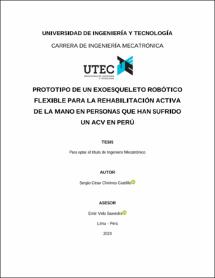Mostrar el registro sencillo del ítem
Prototipo de un exoesqueleto robótico flexible para la rehabilitación activa de la mano en personas que han sufrido un ACV en Perú
| dc.contributor.advisor | Vela Saavedra, Emir Augusto | |
| dc.contributor.author | Chirinos Castillo, Sergio César | |
| dc.date.accessioned | 2023-04-16T02:47:16Z | |
| dc.date.available | 2023-04-16T02:47:16Z | |
| dc.date.issued | 2023 | |
| dc.identifier.citation | Chirinos Castillo, S. C. (2023). Prototipo de un exoesqueleto robótico flexible para la rehabilitación activa de la mano en personas que han sufrido un ACV en Perú [Tesis de Título Profesional, Universidad de Ingeniería y Tecnología]. Repositorio Institucional UTEC. https://hdl.handle.net/20.500.12815/308 | es_PE |
| dc.identifier.uri | https://hdl.handle.net/20.500.12815/308 | |
| dc.description.abstract | Un ACV (accidente cerebro vascular) puede llegar a causar parálisis a múltiples partes del cuerpo, siendo las manos una de las áreas más comunes en ser afectadas. En caso de un paciente con ACV que no reciba una rehabilitación continua e inmediata, aumentará la posibilidad de convertirse en una parálisis permanente o sufrir de distrofia muscular. Debido a que no todos poseen la disponibilidad para asistir a centros privados que pueden realizar un tratamiento eficaz y continuo con la ayuda de un terapeuta para rehabilitar manos después de un ACV, se ha creado este exoesqueleto flexible de rehabilitación muscular que permita ofrecer una nueva alternativa de tratamiento a otras personas. El exoesqueleto posee un modo de rehabilitación que incluye la flexión y el estiramiento de los dedos junto con el agarre de objetos con una fuerza promedio de 3.8 N, para entrenar el área subcortical del cerebro, logrando el objetivo de rehabilitar, eficaz y continuamente, y que apoye al paciente a realizar un entrenamiento muscular de la mano en su casa, para disminuir las múltiples idas diarias a un centro de salud. Además, el exoesqueleto permite entrenar movimientos específicos como agarre cilíndrico y agarre de precisión, que son posiciones que se realizan en actividades diarias, entrenando y recuperando la movilidad de la mano afectada en casa y aumentando las horas de entrenamiento para un mejor resultado. | es_PE |
| dc.description.abstract | A stroke can cause paralysis to multiple parts of the body, with the hands being one of the most common areas to be affected. If a stroke patient do not receive immediate and continuous rehabilitation, the possibility of becoming permanent paralysis or suffering from a muscular dystrophy will increase. Not everyone has the availability to attend private centers that can perform an effective and continuous treatment with the help of a therapist to rehabilitate hands after a stroke, for that reason it is proposed in this project to create a flexible exoskeleton for muscle rehabilitation that grands a new alternative of treatment to other people. The exoskeleton has a rehabilitation mode that include the flexion and stretch of the fingers, including the possibility to grasp objects with an average force of 3.8 N to train the subcortical area of the brain. Achieving an effective and continuous rehabilitation that supports the patient to perform a muscle training of the hand at home, to reduce the multiple daily trips to a health center. In addition, the exoskeleton allows you to train specific movements such as cylindric grasp and precision grasp, which are positions that are performed in daily activities. Completing the goal of training and recovering mobility of the hands at home, and increasing the hours of training for a better result. | es_PE |
| dc.description.uri | Tesis | es_PE |
| dc.format | application/pdf | es_PE |
| dc.language.iso | spa | es_PE |
| dc.publisher | Universidad de Ingeniería y Tecnología | es_PE |
| dc.rights | info:eu-repo/semantics/openAccess | es_PE |
| dc.rights.uri | http://creativecommons.org/licenses/by-nc-nd/4.0/ | |
| dc.source | Repositorio Institucional UTEC | es_PE |
| dc.source | Universidad de Ingeniería y Tecnología - UTEC | es_PE |
| dc.subject | Rehabilitación | es_PE |
| dc.subject | Dispositivo robótico | es_PE |
| dc.subject | Biomecánica | es_PE |
| dc.subject | Terapia física | es_PE |
| dc.subject | Mano | es_PE |
| dc.subject | Rehabilitation | es_PE |
| dc.subject | Biomechanics | es_PE |
| dc.subject | Physiotherapy | es_PE |
| dc.subject | Hand | es_PE |
| dc.title | Prototipo de un exoesqueleto robótico flexible para la rehabilitación activa de la mano en personas que han sufrido un ACV en Perú | es_PE |
| dc.title.alternative | Prototype of a flexible robotic exoeskeleton for active hand rehabilitation after stroke in Perú | es_PE |
| dc.type | info:eu-repo/semantics/bachelorThesis | es_PE |
| dc.subject.ocde | https://purl.org/pe-repo/ocde/ford#2.00.00 | es_PE |
| dc.publisher.country | PE | es_PE |
| thesis.degree.discipline | Ingeniería Mecatrónica | es_PE |
| thesis.degree.grantor | Universidad de Ingeniería y Tecnología. Ingeniería Mecatrónica | es_PE |
| thesis.degree.level | Título Profesional | es_PE |
| thesis.degree.name | Ingeniero Mecatrónico | es_PE |
| renati.advisor.dni | 40063139 | |
| renati.advisor.orcid | https://orcid.org/0000-0002-9397-2452 | es_PE |
| renati.author.dni | 71238755 | |
| renati.author.orcid | https://orcid.org/0000-0001-6635-0319 | es_PE |
| renati.discipline | 713096 | es_PE |
| renati.juror | Vera Pomalaza, Rafael | |
| renati.juror | Aranda Egúsquiza, Sergio | |
| renati.juror | Inga Narváez, Dante | |
| renati.level | http://purl.org/pe-repo/renati/level#tituloProfesional | es_PE |
| renati.type | http://purl.org/pe-repo/renati/type#tesis | es_PE |





